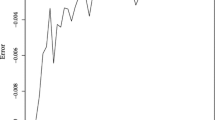Abstract
We show that there exist infinite sets A = (a1, a2, …} and B = {b1, b2, …} of natural numbers such that ai + bj is prime whenever 1 ≤ i < j.
Similar content being viewed by others
References
A. Balog, Linear equations in primes, Mathematika 39 (1992), 367–378.
W. Banks, T. Freiberg and J. Maynard, On limit points of the sequence of normalized prime gaps, Proc. Lond. Math. Soc. (3) 113 (2016), 515–539.
V. Bergelson, Sets of recurrence of ℤm-actions and properties of sets of differences in ℤm, J. London Math. Soc. (2) 31 (1985), 295–304.
C. Chou, Weakly almost periodic functions and thin sets in discrete groups, Trans. Amer. Math. Soc. 321 (1990) 333–346.
Y. Choi and M. J. Heath, Characterizing derivations from the disk algebra to its dual, Proc. Amer. Math. Soc. 139 (2011), 1073–1080.
A. de Polignac, Recherches nouvelles sur les nombres premiers, C. R. Acad. Sci. Paris 29 (1849), 397–401.
L. E. Dickson, A new extension of Dirichlet’s theorem on prime numbers, Messenger of Math. 33 (1904), 155–161.
A. Dymek, S. Kasjan, J. Kułaga-Przymus and M. Lemańczyk, B-free sets and dynamics, Trans. Amer. Math. Soc. 370 (2018), 5425–5489.
P. Erdős, Problems and results in combinatorial number theory, Astérisque 2 (1975), 295–309.
H. Furstenberg, Ergodic behavior of diagonal measures and a theorem of Szemerédi on arithmetic progressions, J. Anal. Math. 31 (1977), 204–256.
P. X. Gallagher, On the distribution of primes in short intervals, Mathematika 23 (1976), 4–9.
A. Granville, A note on sums of primes, Canad. Math. Bull. 33 (1990), 452–454.
B. Green and T. Tao, Linear equations in primes, Ann. of Math. (2) 171 (2010), 1753–1850.
B. Green and T. Tao, The Möbius function is strongly orthogonal to nilsequences, Ann. of Math. (2) 175 (2012), 541–566.
B. Green, T. Tao and T. Ziegler, An inverse theorem for the Gowers Us+1[N]-norm, Ann. of Math. (2) 176 (2012), 1231–1372.
G. H. Hardy and J. E. Littlewood, Some problems of ‘Partitio Numerorum.’ III. On the expression of a number as a sum of primes, Acta Math. 44 (1923), 1–70.
D. Jakobson, Quantum limits on flat tori, Ann. of Math. (2) 145 (1997), 235–266.
A. Kechris, Classical Descriptive Set Theory, Springer, Berlin-New York, 1995.
B. Kra, J. Moreira, F. Richter and D. Robertson, A proof of Erdős’s B + B + t conjecture, arXiv:2206.12377 [math.DS]
J. Maynard, Small gaps between primes, Ann. of Math. (2) 181 (2015), 383–413.
O. McGrath, A variation of the prime k-tuples conjecture with applications to quantum limits, Math. Ann. 384 (2022), 1343–1407.
D. H. J. Polymath, Variants of the Selberg sieve, and bounded intervals containing many primes, Res. Math. Sci. 1 (2014), Article no. 12.
W. A. F. Ruppert, On weakly almost periodic sets, Semigroup Forum 32 (1985), 267–281.
Y. Zhang, Bounded gaps between primes, Ann. of Math. (2) 179 (2014), 1121–1174.
Acknowledgements
The first author is supported by NSF grant DMS-1764034 and by a Simons Investigator Award. The second author is supported by a grant from the Institute for Advanced Study and by ISF grant 2112/20. Part of this research was conducted at the Institute for Advanced Study. We thank Joel Moreira for discussions leading to Section 5, Vitaly Bergelson for informing us of the reference [8], James Maynard for informing us of the reference [21], Yemon Choi for supplying references on translation-finite sets, Mariusz Lemanczyk for pointing out a gap in a previous version of the proof of Corollary 5.2, Joel David Hamkins for providing an argument allowing us to strengthen that corollary, and Keiju Sono for a correction.
Author information
Authors and Affiliations
Corresponding author
Additional information
To Peter, with admiration
Rights and permissions
About this article
Cite this article
Tao, T., Ziegler, T. Infinite partial sumsets in the primes. JAMA 151, 375–389 (2023). https://doi.org/10.1007/s11854-023-0323-y
Received:
Revised:
Published:
Issue Date:
DOI: https://doi.org/10.1007/s11854-023-0323-y



